Analysis of Environmental Impact Assessment Alternatives: EIDC Project
VerifiedAdded on 2021/11/05
|7
|1987
|29
Report
AI Summary
This report provides an environmental impact assessment (EIA) of Endora Inc. Development Company's (EIDC's) plan to develop a 3,000-room destination area near Menehune Bay in Hawaii. The assessment focuses on five key alternatives: location/site, routing, site layout, demand, and input. The current proposal, which involves leasing 500 acres of land (including cultivated areas, fishponds, and an untouched marsh), is critically examined for its potential negative impacts on land use, economic activities, drainage, recreational activities, and ecological modifications. The report highlights the importance of considering alternative sites, routing of infrastructure, site layout, and the use of vacation rentals or boathouses to address the demand for accommodations. Additionally, it suggests sourcing construction inputs locally to create employment opportunities and reduce costs. The conclusion emphasizes the need for careful evaluation of alternatives to ensure efficient, practical, and environmentally sustainable project implementation.
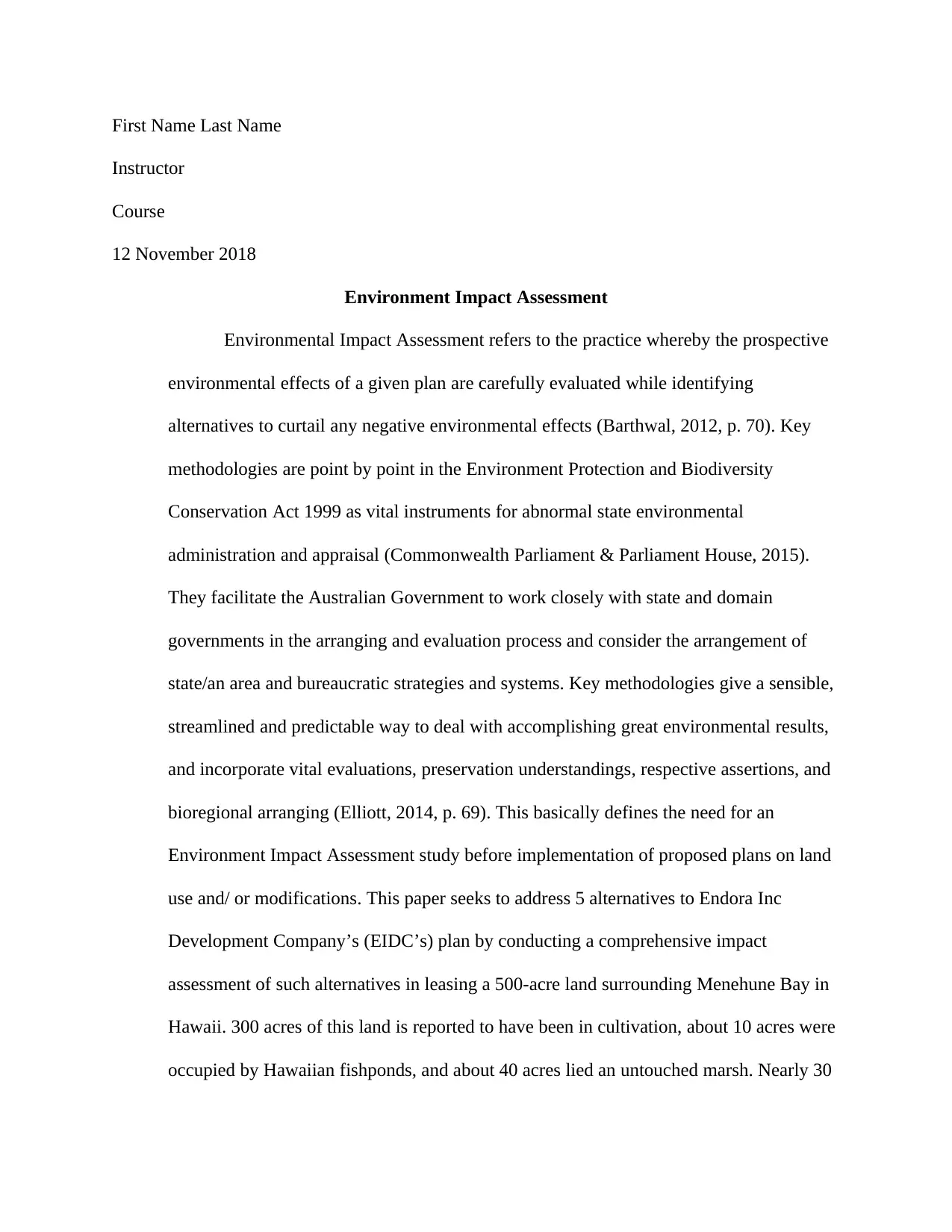
First Name Last Name
Instructor
Course
12 November 2018
Environment Impact Assessment
Environmental Impact Assessment refers to the practice whereby the prospective
environmental effects of a given plan are carefully evaluated while identifying
alternatives to curtail any negative environmental effects (Barthwal, 2012, p. 70). Key
methodologies are point by point in the Environment Protection and Biodiversity
Conservation Act 1999 as vital instruments for abnormal state environmental
administration and appraisal (Commonwealth Parliament & Parliament House, 2015).
They facilitate the Australian Government to work closely with state and domain
governments in the arranging and evaluation process and consider the arrangement of
state/an area and bureaucratic strategies and systems. Key methodologies give a sensible,
streamlined and predictable way to deal with accomplishing great environmental results,
and incorporate vital evaluations, preservation understandings, respective assertions, and
bioregional arranging (Elliott, 2014, p. 69). This basically defines the need for an
Environment Impact Assessment study before implementation of proposed plans on land
use and/ or modifications. This paper seeks to address 5 alternatives to Endora Inc
Development Company’s (EIDC’s) plan by conducting a comprehensive impact
assessment of such alternatives in leasing a 500-acre land surrounding Menehune Bay in
Hawaii. 300 acres of this land is reported to have been in cultivation, about 10 acres were
occupied by Hawaiian fishponds, and about 40 acres lied an untouched marsh. Nearly 30
Instructor
Course
12 November 2018
Environment Impact Assessment
Environmental Impact Assessment refers to the practice whereby the prospective
environmental effects of a given plan are carefully evaluated while identifying
alternatives to curtail any negative environmental effects (Barthwal, 2012, p. 70). Key
methodologies are point by point in the Environment Protection and Biodiversity
Conservation Act 1999 as vital instruments for abnormal state environmental
administration and appraisal (Commonwealth Parliament & Parliament House, 2015).
They facilitate the Australian Government to work closely with state and domain
governments in the arranging and evaluation process and consider the arrangement of
state/an area and bureaucratic strategies and systems. Key methodologies give a sensible,
streamlined and predictable way to deal with accomplishing great environmental results,
and incorporate vital evaluations, preservation understandings, respective assertions, and
bioregional arranging (Elliott, 2014, p. 69). This basically defines the need for an
Environment Impact Assessment study before implementation of proposed plans on land
use and/ or modifications. This paper seeks to address 5 alternatives to Endora Inc
Development Company’s (EIDC’s) plan by conducting a comprehensive impact
assessment of such alternatives in leasing a 500-acre land surrounding Menehune Bay in
Hawaii. 300 acres of this land is reported to have been in cultivation, about 10 acres were
occupied by Hawaiian fishponds, and about 40 acres lied an untouched marsh. Nearly 30
Paraphrase This Document
Need a fresh take? Get an instant paraphrase of this document with our AI Paraphraser
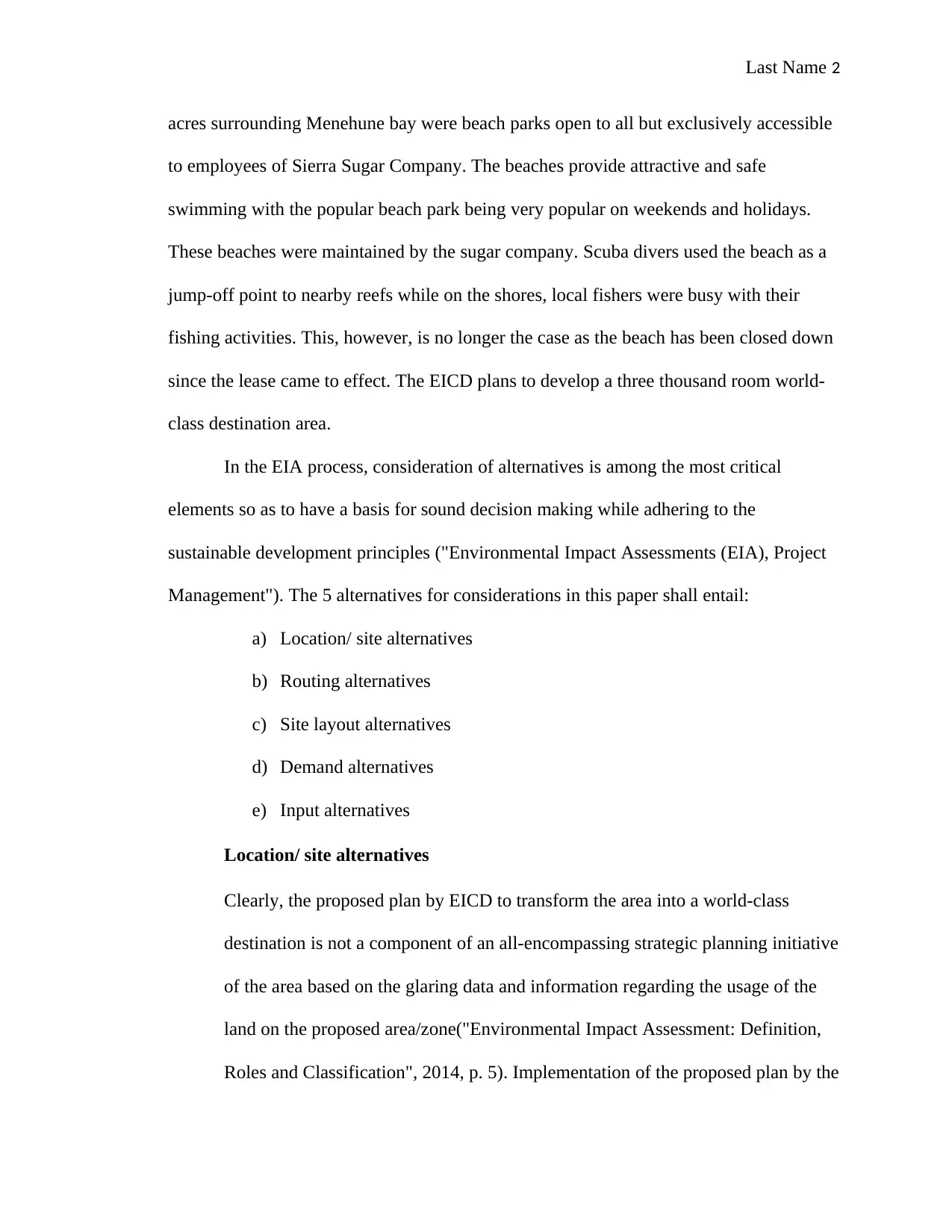
Last Name 2
acres surrounding Menehune bay were beach parks open to all but exclusively accessible
to employees of Sierra Sugar Company. The beaches provide attractive and safe
swimming with the popular beach park being very popular on weekends and holidays.
These beaches were maintained by the sugar company. Scuba divers used the beach as a
jump-off point to nearby reefs while on the shores, local fishers were busy with their
fishing activities. This, however, is no longer the case as the beach has been closed down
since the lease came to effect. The EICD plans to develop a three thousand room world-
class destination area.
In the EIA process, consideration of alternatives is among the most critical
elements so as to have a basis for sound decision making while adhering to the
sustainable development principles ("Environmental Impact Assessments (EIA), Project
Management"). The 5 alternatives for considerations in this paper shall entail:
a) Location/ site alternatives
b) Routing alternatives
c) Site layout alternatives
d) Demand alternatives
e) Input alternatives
Location/ site alternatives
Clearly, the proposed plan by EICD to transform the area into a world-class
destination is not a component of an all-encompassing strategic planning initiative
of the area based on the glaring data and information regarding the usage of the
land on the proposed area/zone("Environmental Impact Assessment: Definition,
Roles and Classification", 2014, p. 5). Implementation of the proposed plan by the
acres surrounding Menehune bay were beach parks open to all but exclusively accessible
to employees of Sierra Sugar Company. The beaches provide attractive and safe
swimming with the popular beach park being very popular on weekends and holidays.
These beaches were maintained by the sugar company. Scuba divers used the beach as a
jump-off point to nearby reefs while on the shores, local fishers were busy with their
fishing activities. This, however, is no longer the case as the beach has been closed down
since the lease came to effect. The EICD plans to develop a three thousand room world-
class destination area.
In the EIA process, consideration of alternatives is among the most critical
elements so as to have a basis for sound decision making while adhering to the
sustainable development principles ("Environmental Impact Assessments (EIA), Project
Management"). The 5 alternatives for considerations in this paper shall entail:
a) Location/ site alternatives
b) Routing alternatives
c) Site layout alternatives
d) Demand alternatives
e) Input alternatives
Location/ site alternatives
Clearly, the proposed plan by EICD to transform the area into a world-class
destination is not a component of an all-encompassing strategic planning initiative
of the area based on the glaring data and information regarding the usage of the
land on the proposed area/zone("Environmental Impact Assessment: Definition,
Roles and Classification", 2014, p. 5). Implementation of the proposed plan by the
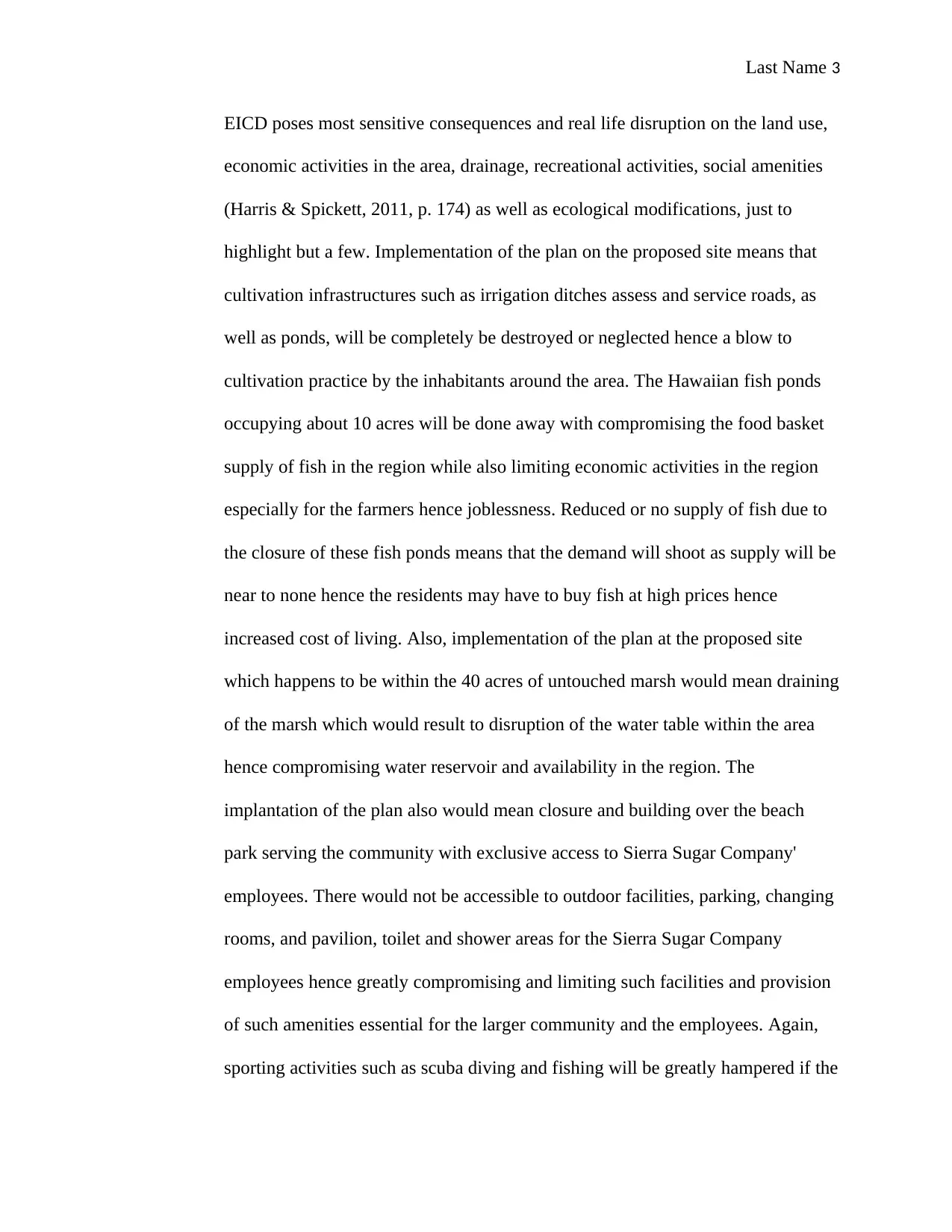
Last Name 3
EICD poses most sensitive consequences and real life disruption on the land use,
economic activities in the area, drainage, recreational activities, social amenities
(Harris & Spickett, 2011, p. 174) as well as ecological modifications, just to
highlight but a few. Implementation of the plan on the proposed site means that
cultivation infrastructures such as irrigation ditches assess and service roads, as
well as ponds, will be completely be destroyed or neglected hence a blow to
cultivation practice by the inhabitants around the area. The Hawaiian fish ponds
occupying about 10 acres will be done away with compromising the food basket
supply of fish in the region while also limiting economic activities in the region
especially for the farmers hence joblessness. Reduced or no supply of fish due to
the closure of these fish ponds means that the demand will shoot as supply will be
near to none hence the residents may have to buy fish at high prices hence
increased cost of living. Also, implementation of the plan at the proposed site
which happens to be within the 40 acres of untouched marsh would mean draining
of the marsh which would result to disruption of the water table within the area
hence compromising water reservoir and availability in the region. The
implantation of the plan also would mean closure and building over the beach
park serving the community with exclusive access to Sierra Sugar Company'
employees. There would not be accessible to outdoor facilities, parking, changing
rooms, and pavilion, toilet and shower areas for the Sierra Sugar Company
employees hence greatly compromising and limiting such facilities and provision
of such amenities essential for the larger community and the employees. Again,
sporting activities such as scuba diving and fishing will be greatly hampered if the
EICD poses most sensitive consequences and real life disruption on the land use,
economic activities in the area, drainage, recreational activities, social amenities
(Harris & Spickett, 2011, p. 174) as well as ecological modifications, just to
highlight but a few. Implementation of the plan on the proposed site means that
cultivation infrastructures such as irrigation ditches assess and service roads, as
well as ponds, will be completely be destroyed or neglected hence a blow to
cultivation practice by the inhabitants around the area. The Hawaiian fish ponds
occupying about 10 acres will be done away with compromising the food basket
supply of fish in the region while also limiting economic activities in the region
especially for the farmers hence joblessness. Reduced or no supply of fish due to
the closure of these fish ponds means that the demand will shoot as supply will be
near to none hence the residents may have to buy fish at high prices hence
increased cost of living. Also, implementation of the plan at the proposed site
which happens to be within the 40 acres of untouched marsh would mean draining
of the marsh which would result to disruption of the water table within the area
hence compromising water reservoir and availability in the region. The
implantation of the plan also would mean closure and building over the beach
park serving the community with exclusive access to Sierra Sugar Company'
employees. There would not be accessible to outdoor facilities, parking, changing
rooms, and pavilion, toilet and shower areas for the Sierra Sugar Company
employees hence greatly compromising and limiting such facilities and provision
of such amenities essential for the larger community and the employees. Again,
sporting activities such as scuba diving and fishing will be greatly hampered if the
⊘ This is a preview!⊘
Do you want full access?
Subscribe today to unlock all pages.

Trusted by 1+ million students worldwide
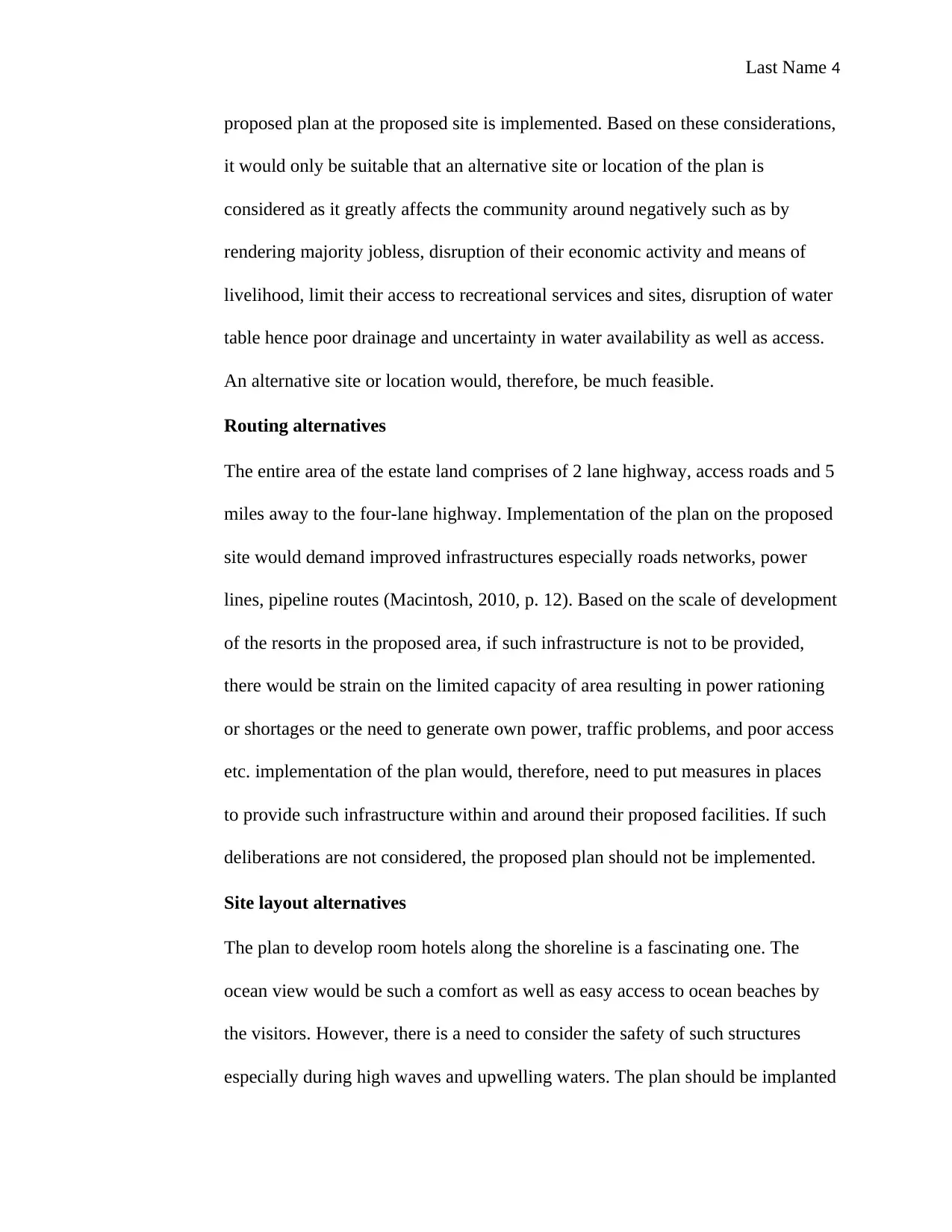
Last Name 4
proposed plan at the proposed site is implemented. Based on these considerations,
it would only be suitable that an alternative site or location of the plan is
considered as it greatly affects the community around negatively such as by
rendering majority jobless, disruption of their economic activity and means of
livelihood, limit their access to recreational services and sites, disruption of water
table hence poor drainage and uncertainty in water availability as well as access.
An alternative site or location would, therefore, be much feasible.
Routing alternatives
The entire area of the estate land comprises of 2 lane highway, access roads and 5
miles away to the four-lane highway. Implementation of the plan on the proposed
site would demand improved infrastructures especially roads networks, power
lines, pipeline routes (Macintosh, 2010, p. 12). Based on the scale of development
of the resorts in the proposed area, if such infrastructure is not to be provided,
there would be strain on the limited capacity of area resulting in power rationing
or shortages or the need to generate own power, traffic problems, and poor access
etc. implementation of the plan would, therefore, need to put measures in places
to provide such infrastructure within and around their proposed facilities. If such
deliberations are not considered, the proposed plan should not be implemented.
Site layout alternatives
The plan to develop room hotels along the shoreline is a fascinating one. The
ocean view would be such a comfort as well as easy access to ocean beaches by
the visitors. However, there is a need to consider the safety of such structures
especially during high waves and upwelling waters. The plan should be implanted
proposed plan at the proposed site is implemented. Based on these considerations,
it would only be suitable that an alternative site or location of the plan is
considered as it greatly affects the community around negatively such as by
rendering majority jobless, disruption of their economic activity and means of
livelihood, limit their access to recreational services and sites, disruption of water
table hence poor drainage and uncertainty in water availability as well as access.
An alternative site or location would, therefore, be much feasible.
Routing alternatives
The entire area of the estate land comprises of 2 lane highway, access roads and 5
miles away to the four-lane highway. Implementation of the plan on the proposed
site would demand improved infrastructures especially roads networks, power
lines, pipeline routes (Macintosh, 2010, p. 12). Based on the scale of development
of the resorts in the proposed area, if such infrastructure is not to be provided,
there would be strain on the limited capacity of area resulting in power rationing
or shortages or the need to generate own power, traffic problems, and poor access
etc. implementation of the plan would, therefore, need to put measures in places
to provide such infrastructure within and around their proposed facilities. If such
deliberations are not considered, the proposed plan should not be implemented.
Site layout alternatives
The plan to develop room hotels along the shoreline is a fascinating one. The
ocean view would be such a comfort as well as easy access to ocean beaches by
the visitors. However, there is a need to consider the safety of such structures
especially during high waves and upwelling waters. The plan should be implanted
Paraphrase This Document
Need a fresh take? Get an instant paraphrase of this document with our AI Paraphraser
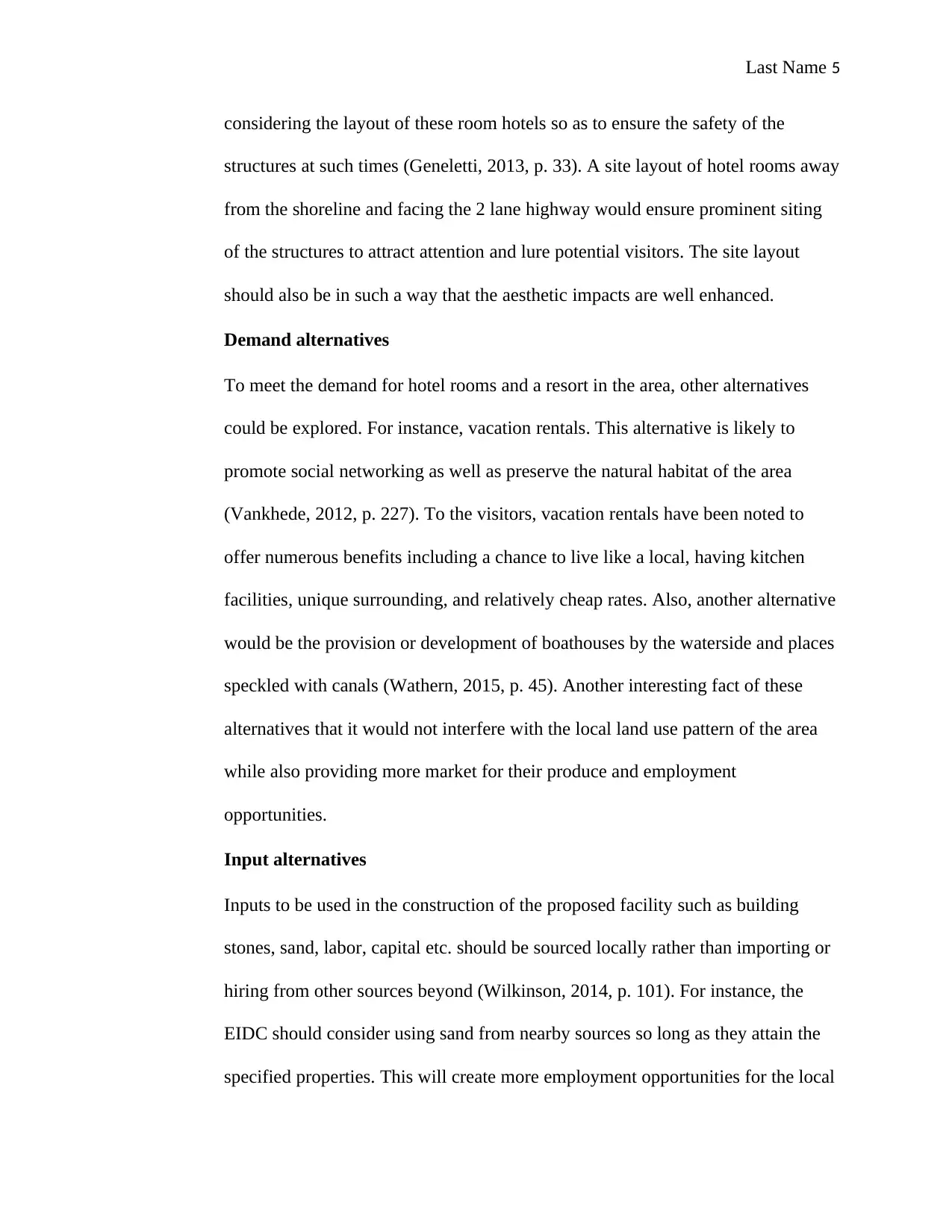
Last Name 5
considering the layout of these room hotels so as to ensure the safety of the
structures at such times (Geneletti, 2013, p. 33). A site layout of hotel rooms away
from the shoreline and facing the 2 lane highway would ensure prominent siting
of the structures to attract attention and lure potential visitors. The site layout
should also be in such a way that the aesthetic impacts are well enhanced.
Demand alternatives
To meet the demand for hotel rooms and a resort in the area, other alternatives
could be explored. For instance, vacation rentals. This alternative is likely to
promote social networking as well as preserve the natural habitat of the area
(Vankhede, 2012, p. 227). To the visitors, vacation rentals have been noted to
offer numerous benefits including a chance to live like a local, having kitchen
facilities, unique surrounding, and relatively cheap rates. Also, another alternative
would be the provision or development of boathouses by the waterside and places
speckled with canals (Wathern, 2015, p. 45). Another interesting fact of these
alternatives that it would not interfere with the local land use pattern of the area
while also providing more market for their produce and employment
opportunities.
Input alternatives
Inputs to be used in the construction of the proposed facility such as building
stones, sand, labor, capital etc. should be sourced locally rather than importing or
hiring from other sources beyond (Wilkinson, 2014, p. 101). For instance, the
EIDC should consider using sand from nearby sources so long as they attain the
specified properties. This will create more employment opportunities for the local
considering the layout of these room hotels so as to ensure the safety of the
structures at such times (Geneletti, 2013, p. 33). A site layout of hotel rooms away
from the shoreline and facing the 2 lane highway would ensure prominent siting
of the structures to attract attention and lure potential visitors. The site layout
should also be in such a way that the aesthetic impacts are well enhanced.
Demand alternatives
To meet the demand for hotel rooms and a resort in the area, other alternatives
could be explored. For instance, vacation rentals. This alternative is likely to
promote social networking as well as preserve the natural habitat of the area
(Vankhede, 2012, p. 227). To the visitors, vacation rentals have been noted to
offer numerous benefits including a chance to live like a local, having kitchen
facilities, unique surrounding, and relatively cheap rates. Also, another alternative
would be the provision or development of boathouses by the waterside and places
speckled with canals (Wathern, 2015, p. 45). Another interesting fact of these
alternatives that it would not interfere with the local land use pattern of the area
while also providing more market for their produce and employment
opportunities.
Input alternatives
Inputs to be used in the construction of the proposed facility such as building
stones, sand, labor, capital etc. should be sourced locally rather than importing or
hiring from other sources beyond (Wilkinson, 2014, p. 101). For instance, the
EIDC should consider using sand from nearby sources so long as they attain the
specified properties. This will create more employment opportunities for the local
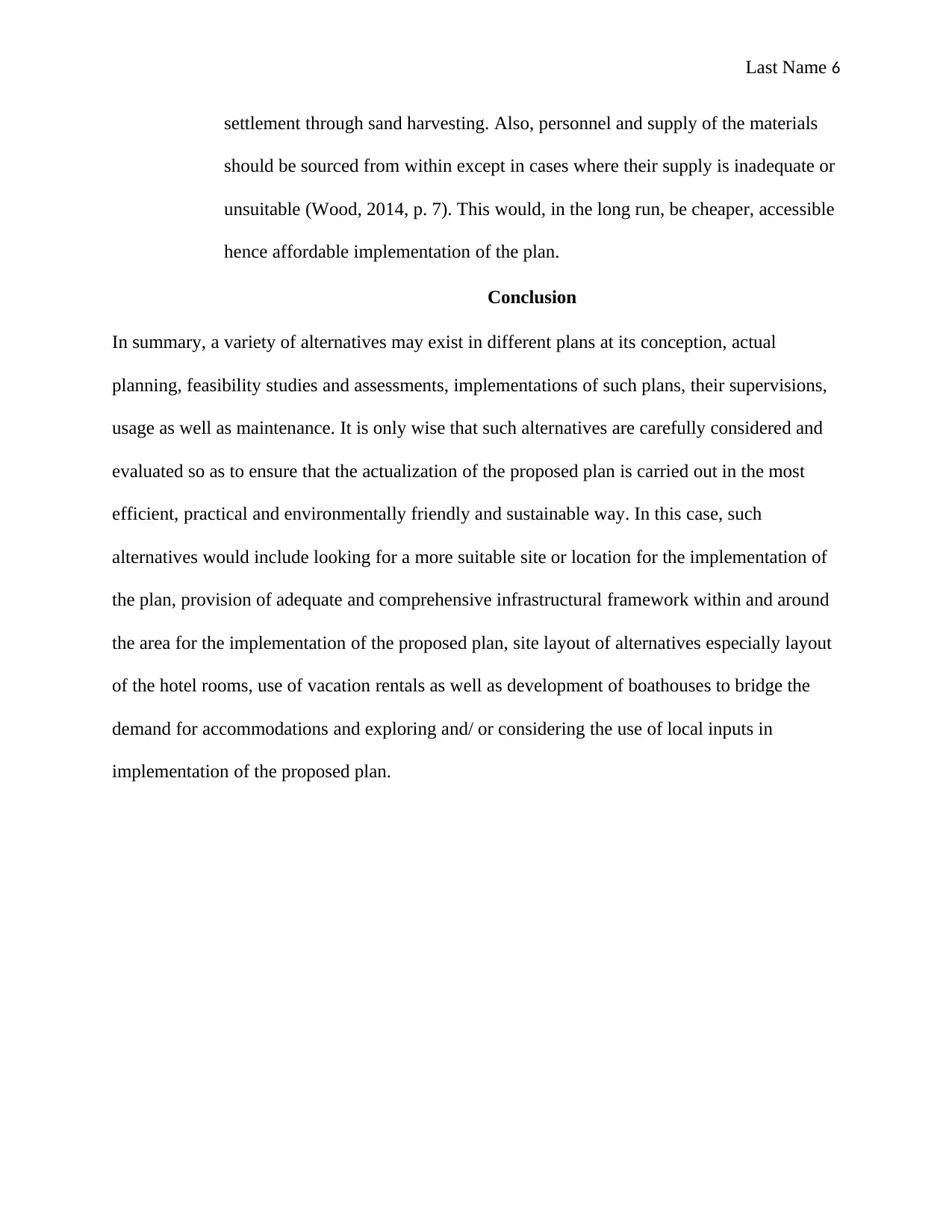
Last Name 6
settlement through sand harvesting. Also, personnel and supply of the materials
should be sourced from within except in cases where their supply is inadequate or
unsuitable (Wood, 2014, p. 7). This would, in the long run, be cheaper, accessible
hence affordable implementation of the plan.
Conclusion
In summary, a variety of alternatives may exist in different plans at its conception, actual
planning, feasibility studies and assessments, implementations of such plans, their supervisions,
usage as well as maintenance. It is only wise that such alternatives are carefully considered and
evaluated so as to ensure that the actualization of the proposed plan is carried out in the most
efficient, practical and environmentally friendly and sustainable way. In this case, such
alternatives would include looking for a more suitable site or location for the implementation of
the plan, provision of adequate and comprehensive infrastructural framework within and around
the area for the implementation of the proposed plan, site layout of alternatives especially layout
of the hotel rooms, use of vacation rentals as well as development of boathouses to bridge the
demand for accommodations and exploring and/ or considering the use of local inputs in
implementation of the proposed plan.
settlement through sand harvesting. Also, personnel and supply of the materials
should be sourced from within except in cases where their supply is inadequate or
unsuitable (Wood, 2014, p. 7). This would, in the long run, be cheaper, accessible
hence affordable implementation of the plan.
Conclusion
In summary, a variety of alternatives may exist in different plans at its conception, actual
planning, feasibility studies and assessments, implementations of such plans, their supervisions,
usage as well as maintenance. It is only wise that such alternatives are carefully considered and
evaluated so as to ensure that the actualization of the proposed plan is carried out in the most
efficient, practical and environmentally friendly and sustainable way. In this case, such
alternatives would include looking for a more suitable site or location for the implementation of
the plan, provision of adequate and comprehensive infrastructural framework within and around
the area for the implementation of the proposed plan, site layout of alternatives especially layout
of the hotel rooms, use of vacation rentals as well as development of boathouses to bridge the
demand for accommodations and exploring and/ or considering the use of local inputs in
implementation of the proposed plan.
⊘ This is a preview!⊘
Do you want full access?
Subscribe today to unlock all pages.

Trusted by 1+ million students worldwide
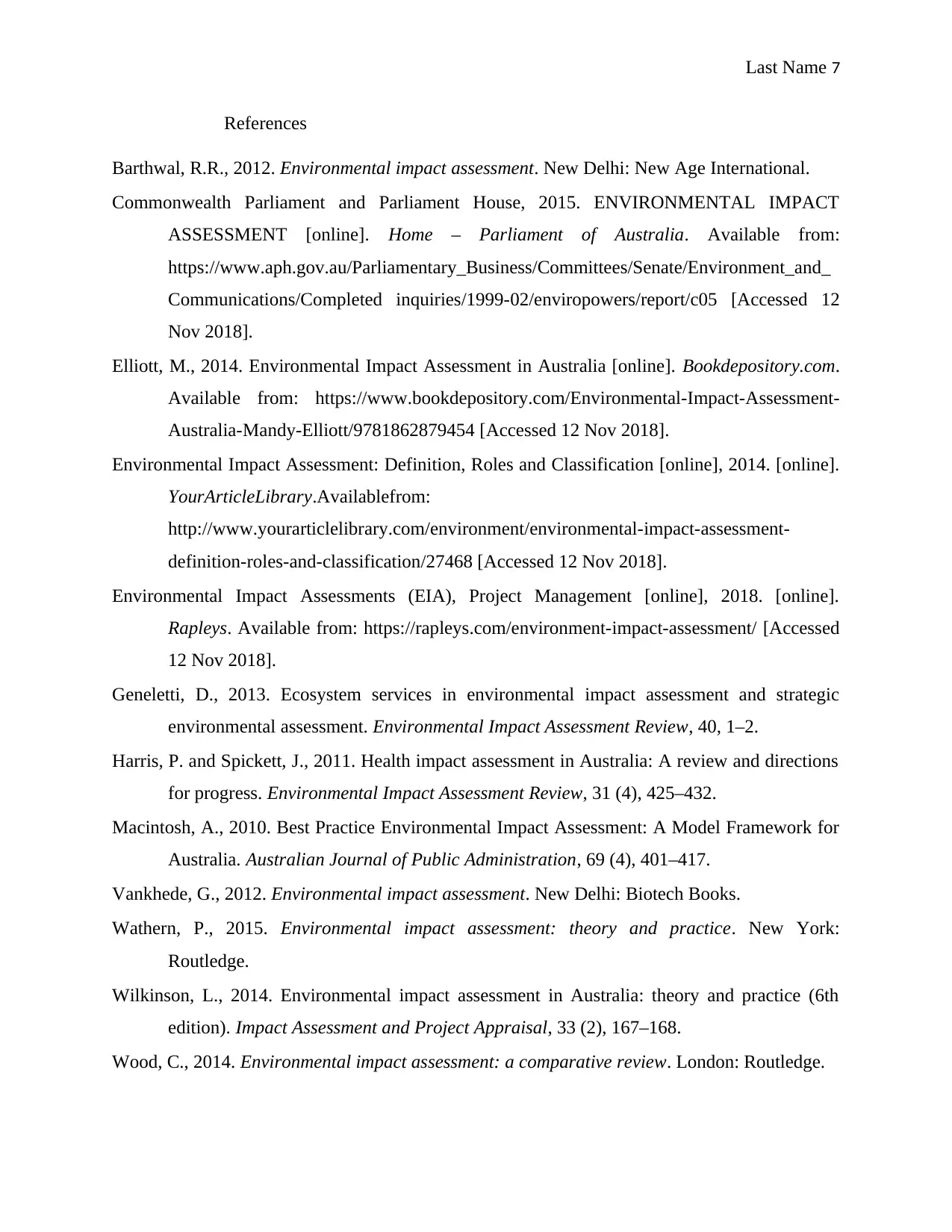
Last Name 7
References
Barthwal, R.R., 2012. Environmental impact assessment. New Delhi: New Age International.
Commonwealth Parliament and Parliament House, 2015. ENVIRONMENTAL IMPACT
ASSESSMENT [online]. Home – Parliament of Australia. Available from:
https://www.aph.gov.au/Parliamentary_Business/Committees/Senate/Environment_and_
Communications/Completed inquiries/1999-02/enviropowers/report/c05 [Accessed 12
Nov 2018].
Elliott, M., 2014. Environmental Impact Assessment in Australia [online]. Bookdepository.com.
Available from: https://www.bookdepository.com/Environmental-Impact-Assessment-
Australia-Mandy-Elliott/9781862879454 [Accessed 12 Nov 2018].
Environmental Impact Assessment: Definition, Roles and Classification [online], 2014. [online].
YourArticleLibrary.Availablefrom:
http://www.yourarticlelibrary.com/environment/environmental-impact-assessment-
definition-roles-and-classification/27468 [Accessed 12 Nov 2018].
Environmental Impact Assessments (EIA), Project Management [online], 2018. [online].
Rapleys. Available from: https://rapleys.com/environment-impact-assessment/ [Accessed
12 Nov 2018].
Geneletti, D., 2013. Ecosystem services in environmental impact assessment and strategic
environmental assessment. Environmental Impact Assessment Review, 40, 1–2.
Harris, P. and Spickett, J., 2011. Health impact assessment in Australia: A review and directions
for progress. Environmental Impact Assessment Review, 31 (4), 425–432.
Macintosh, A., 2010. Best Practice Environmental Impact Assessment: A Model Framework for
Australia. Australian Journal of Public Administration, 69 (4), 401–417.
Vankhede, G., 2012. Environmental impact assessment. New Delhi: Biotech Books.
Wathern, P., 2015. Environmental impact assessment: theory and practice. New York:
Routledge.
Wilkinson, L., 2014. Environmental impact assessment in Australia: theory and practice (6th
edition). Impact Assessment and Project Appraisal, 33 (2), 167–168.
Wood, C., 2014. Environmental impact assessment: a comparative review. London: Routledge.
References
Barthwal, R.R., 2012. Environmental impact assessment. New Delhi: New Age International.
Commonwealth Parliament and Parliament House, 2015. ENVIRONMENTAL IMPACT
ASSESSMENT [online]. Home – Parliament of Australia. Available from:
https://www.aph.gov.au/Parliamentary_Business/Committees/Senate/Environment_and_
Communications/Completed inquiries/1999-02/enviropowers/report/c05 [Accessed 12
Nov 2018].
Elliott, M., 2014. Environmental Impact Assessment in Australia [online]. Bookdepository.com.
Available from: https://www.bookdepository.com/Environmental-Impact-Assessment-
Australia-Mandy-Elliott/9781862879454 [Accessed 12 Nov 2018].
Environmental Impact Assessment: Definition, Roles and Classification [online], 2014. [online].
YourArticleLibrary.Availablefrom:
http://www.yourarticlelibrary.com/environment/environmental-impact-assessment-
definition-roles-and-classification/27468 [Accessed 12 Nov 2018].
Environmental Impact Assessments (EIA), Project Management [online], 2018. [online].
Rapleys. Available from: https://rapleys.com/environment-impact-assessment/ [Accessed
12 Nov 2018].
Geneletti, D., 2013. Ecosystem services in environmental impact assessment and strategic
environmental assessment. Environmental Impact Assessment Review, 40, 1–2.
Harris, P. and Spickett, J., 2011. Health impact assessment in Australia: A review and directions
for progress. Environmental Impact Assessment Review, 31 (4), 425–432.
Macintosh, A., 2010. Best Practice Environmental Impact Assessment: A Model Framework for
Australia. Australian Journal of Public Administration, 69 (4), 401–417.
Vankhede, G., 2012. Environmental impact assessment. New Delhi: Biotech Books.
Wathern, P., 2015. Environmental impact assessment: theory and practice. New York:
Routledge.
Wilkinson, L., 2014. Environmental impact assessment in Australia: theory and practice (6th
edition). Impact Assessment and Project Appraisal, 33 (2), 167–168.
Wood, C., 2014. Environmental impact assessment: a comparative review. London: Routledge.
1 out of 7
Your All-in-One AI-Powered Toolkit for Academic Success.
+13062052269
info@desklib.com
Available 24*7 on WhatsApp / Email
![[object Object]](/_next/static/media/star-bottom.7253800d.svg)
Unlock your academic potential
Copyright © 2020–2025 A2Z Services. All Rights Reserved. Developed and managed by ZUCOL.